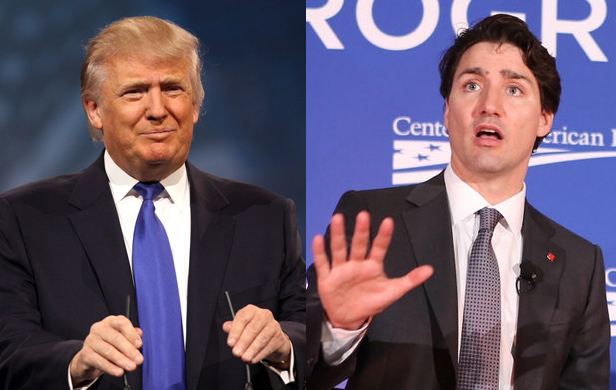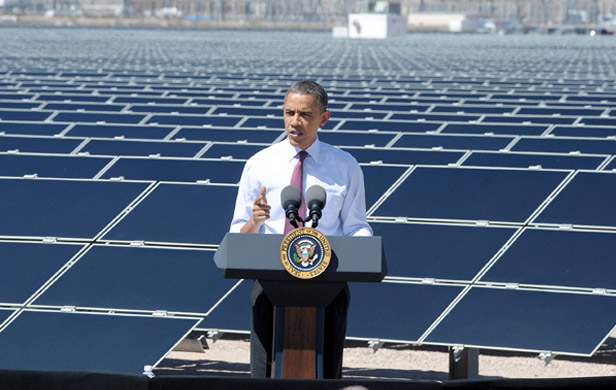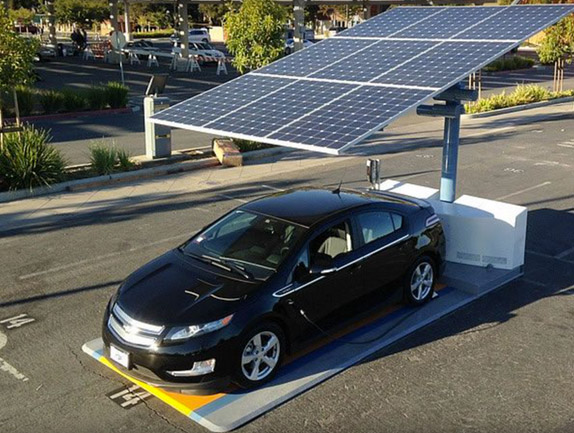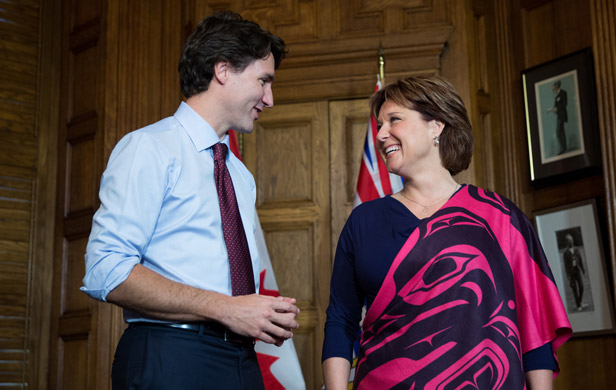
Forces at play suggest there will continue to be significant advancements in the global migration to a green economy. Trudeau and Trump are rowing against the current.
Despite Trudeau’s continued focus on tar sands extraction and limiting provincial action on climate change; despite Trump’s obsession with fossil fuels – coal in particular – the US and Canada will be swept up in these global green economy currents.
Moreover, these global forces strengthen the case that the proposed tar sands pipelines – Kinder Morgan, Energy East and Keystone XL in particular – are redundant, superfluous or pipelines to nowhere.
Trudeau stuck on resource economy
One can be understandably be pessimistic with Trump’s appointment of climate change deniers to his Cabinet. In Canada, there are also grounds for pessimism given Trudeau’s recent track record, including:
- Approving or backing the Kinder Morgan, Line 3 and Keystone XL pipelines, plus two BC LNG plants – Petronas and Woodfibre – and BC’s Site C dam
- His favourable view on the Energy East pipeline, to the effect that he said that opposition to this pipeline is not based on science
- A razor-thin climate plan, stemming from the agreement with most of the provinces
- Backing Alberta’s 100 megatonne/year lid on tar sands emissions, which would leave wiggle room to raise annual tar sands-related emissions by 40%
- This means it would be very difficult to meet even the Conservative GHG reduction target, one now adopted by the Liberals and calling for a measly 30% yearly GHG reduction in 2030 relative to 2005 levels
- His heavy reliance on carbon pricing, despite the fact that, as a stand-alone measure, this is not likely to be very effective – especially with low oil prices and the low carbon price proposed
- Confirming in his 2016-17 Budget the National Energy Board’s (NEB) role for environmental impact assessments for pipelines
- His plan to modernize the NEB subsequent to a 3 year-long process entailing advice from a panel of 5 people, 3 of whom are close to the oil and gas industry
On the issue of over-relying on carbon pricing, two provinces come to mind. First, BC has a $30/tonne carbon tax, but the government is quite comfortable with the Petronas-backed Pacific Northwest LNG facility and the $6 Billion Pacific Trails gas pipeline to connect to BC’s northeast shale gas to the LNG facility. This project alone would raise BC’s emissions by 6.5 to 8.7 megatonnes/year or an 8.5% increase in GHGs/year.
A second case in point is Quebec. Despite its cap and trade system, it went ahead with new legislation to facilitate the exploitation of fossil fuels in the province and $450 million in public subsidies for a cement facility in Port-Daniel, which would become one of the greatest sources of emissions in the province at 1.7 million tonnes of CO2 equivalent/year.
The current Quebec government is also favourable on Energy East.
And yet…renewables are now cheaper than coal

Let’s take a look at the emerging energy landscape in the US.
Trump’s rhetoric aside, the falling cost of renewables will make it hard for Trump to give full priority to fossil fuels in the electricity sector. Since 2009 in the US, the cost of solar has been cut by nearly half and wind has fallen by two thirds. Solar and wind installations are now cheaper than coal in many parts of the US. This trend is exemplified by the fact that 99% of new US generation capacity in the first quarter of 2016 was represented by renewables, 64% from solar. For the year 2016, renewables will likely account for two thirds of new capacity.
As a result, there is now 20 gigawatts (GW) of wind capacity under construction in the US, or in an advanced development stage, which will ultimately raise the US total wind capacity beyond its current 75 GW. What Trump will not be able to ignore are the 88,000 jobs in the US wind sector, especially the 21,000 jobs in US wind tech manufacturing.
As for solar, it is poised to shake up global markets as unsubsidized solar is beginning to outcompete coal and is coming in below the cost of wind projects.
This reality undermines Trump’s ambitions for revitalizing the industry with “clean coal.” Not only has the popularity of renewables and natural gas resulted in the producers of 45% of the country’s coal output having filed for bankruptcy, but also the least expensive, least costly and easiest to mine US coal sources have been fully exploited, making a return to the good old, cheap coal days unlikely. Against this backdrop, 11 GW to 14 GW of US coal capacity went offline in 2015.
Further on Trump’s promise to bring back coal jobs, these new economics had the US solar sector adding more jobs in 2015 than the US oil, gas and pipeline sectors combined.
And despite Trump’s rhetoric, he will not be able to counteract the global implications of China, the world’s largest energy consumer, which continues to shake up global energy economics with its massive investments in renewables and its war on coal. Not only has coal dropped from 80% of China’s electrical generation sources in 2011 to 70% in 2015, but the projections are that by 2025 coal will represent just 55% of China’s electricity mix.
With the 2 principal consumers of coal, China and the US, at the precipice of massive declines in demand for coal, the International Energy Agency is projecting global coal demand to stagnate over the next 5 years.
Also on the global scale, emerging economies are giving priority to solar energy. Auctions in Chile and India have had solar coming in at half the price of coal power. Accordingly, the amount of solar PV added globally is likely to exceed wind capacity additions with as much as 70 GW installed in 2016, compared to 59 GW of wind.
With US coal exports largely dependent on China and India, this all spells more bad news for the US coal industry.
Within the next decade, global clean energy installations will represent more new capacity added than coal and natural gas combined. This green revolution is advancing more quickly in emerging markets, where renewable energy investments were greater in 2015, at $154.1 Billion, than in OECD countries, at $153.7 Billion.
Automotive sector shifting fast to electric

But the most significant cause for optimism lies ahead, with the shift towards low and zero-emission vehicles being imminent. This has major implications for future oil demand, since the transportation sector represents 55% of global petroleum demand.
Here, China continues to lead the way. Up from 331,000 electric vehicles sold in the country in 2015, the projection for 2016 is for 400,000 vehicles – giving us every reason to believe China will meet its target to manufacture 2 million eco-vehicles/year by 2020.
European nations are joining the bandwagon. The German federal upper house, the Bundesrat, adopted a motion to ban internal combustion engine vehicles from the new vehicle market after 2030. Meanwhile, Norway has passed legislation to do the same by 2025, and the Netherlands may well join them.
In effect, Norway is leading the pack, as this country is well on its way to achieving its targets, with nearly half of its 2016 new vehicle sales being plug-in hybrids and electric vehicles, up from 28% in 2015.
With respect to the vehicle manufacturers, it is not just that Volkswagen has announced an investment of $11 Billion in a battery manufacturing facility or its projection that 20% to 25% of its sales will be electric during the 2020 to 2025 period. Many vehicle manufacturers are actively preparing for the introduction of low and zero emission vehicles. Ford, Hyundai-Kia, Volkswagen, Mercedes, BMW, Toyota and Volvo, all have ambitious plans for a wide range of electric and plug-in hybrid models by 2020.
Concurrently, the entry of electric trucks into the marketplace will also make a difference.
China’s electric vehicle-leading enterprise, BYD, will soon triple the 400 employees at its e-bus manufacturing facility in California to make trucks, as well as more buses. Canada’s Lion Bus, manufacturer of electric school buses, will be adding class 5, 6, 7 and 8 trucks to its lineup. Mack Trucks is working in collaboration with Wrightspeed to produce an electric garbage truck and Tesla has added trucks to its Master Plan.
In keeping with these considerations, by 2020, the UK will have more charging stations than gasoline stations. In effect, it appears that Shell’s UK arm also sees the writing on the wall in that the company is thinking of introducing charging stations at its service stations. This my happen as early as 2017.
European automakers are also getting into the act. In November, 2016, Daimler, BMW, Ford and the Volkswagen group (the latter includes Audi and Porsche) signed a Memorandum of Understanding to set up a fast Combined Charging System to cover common long distance travel routes in Europe – 400 station locations in all. The development of the network would begin in 2017 and the goal will be to have thousands of fast charging points on the continent by 2020. Other partners/manufacturers would be welcome to join the network. These fast charging stations will offer up to 350 kW of power, compared with Tesla’s fast chargers, which deliver 120-135 kW.
The Combined Charging System will be complemented by Hubject, a cross-provider, cross-border e-Roaming platform that connects 40,000 charge points worldwide. Charging point locations, availability and payments will be possible with the one application. The application is backed by a European consortium that includes Volkswagen, Daimler, BMW and Siemens.
Going one step further, the EU recently approved regulations that all new and renovated homes and apartments must have charging stations in place beginning 2019.
California will be adopting similar requirements to the effect that all new buildings and parking lots must have the wiring and control panels in place to receive charging stations.
Speaking of the US, Chargepoint, a private supplier of charging stations, installed its 30,000th station in August 2016.
On the downside, Trump may weaken or eliminate regulations for the vehicle manufacturers to improve their respective corporate average fuel economies. That said, the global government policy momentum and global private sector competition among the world’s vehicle manufacturers will ensure a progression to low and zero emission vehicles regardless.
Canada and the US will have to change
Currently, the global supply of petroleum on the market exceeds global demand. This is the result of a flattening of demand, combined with an abundance of new supply sources, due in part to the production of US shale oil, together with existing tar sands exploitation.
An internal memo to the federal Deputy Minister of Finance, released to the public in mid-July, 2016, indicated that existing pipeline capacity is sufficient to accommodate tar sands industry needs until 2025.
Not surprisingly, Dinara Millington, Vice-President of the Canadian Energy Research Institute, echoes the end of the era of exponential oil demand growth by pointing out that the decline oil prices is a reflection of the collapse of the traditional supply-demand model. The demand has not materialized to accommodate increased supply in international markets.
To this effect, Exxon is reassessing 3.6 Billion barrels of oil sands reserves and several other oil firms, Chevron and Shell included, have lowered their valuations of reserves by more than $50 Billion since 2014. More recently, Norway’s Statoil announced its withdrawal from tar sands investments at a loss of $500-550 million.
Also a liability for Canada’s tar sands, Canada’s bitumen is a lower quality oil which only US Gulf Coast refineries are capable of handling. The result is Canada’s bitumen will acquire a lower price in European and Asian markets than conventional supplies.
Trudeau on wrong track

The pending decline in the appetite of the transportation sector for petroleum combined with the unstoppable momentum of the global green economy, indicate that Canada, with its big push on pipelines, is on the wrong track.
The Trudeau’s continued focus on pipelines and resource economy means it is unlikely that Canada will achieve even the poor Conservative GHG reduction target it has adopted. This is sad since there are 6 to 8 times more jobs per government investment unit created by investments in green jobs than from funds sunk into the traditional resource sectors.
Case in point: Quebec’s electric vehicle sector is not on the federal radar screen. (This sector includes 2 battery manufacturers; work underway on the development of a super battery; 2 charging station manufacturers; a developer of an electric motor wheel; an electric school bus manufacturer which plans on branching out into truck classes 5 to 8; a manufacturer of an urban transit electric bus soon to be included in a pilot project in Montreal; and several research facilities)
Whether they like it or not, the above facts mean that Trudeau and Trump will soon be forced to adjust their respective mindsets to address the emerging global green economy.


ONE COMMENT! Plus this one. Is that because its a boring subject, or because no-one reads the Commonsensecanadian? There are 4 million of us just in BC (okay, not all 4 million can read. Yet.) This issue is of vital concern to all of us, climate change deniers included. Even if you don’t believe in global warming, renewables are the future. Read and heed, preferably before May 8th.
Thank you.
Oh that is cold! Trump and Trudeau photos together like that. Right now all Trudeau has going for him is that he isn’t Trump. That is a big plus.